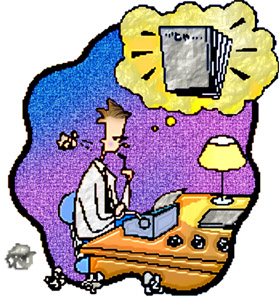 Writer’s block can be a frustrating and intimidating experience. Staring at a blank computer screen, with the cursor blinking defiantly back at you. With each flicker of the cursor the brick wall between the mind and the fingers gets built higher and higher, until it seems there is no way to ever climb over it; with each flicker the wall grows thicker, making it impossible to break through. Writer’s block tends to occur at the most inconvenient time: when you are running out of time. It happens when you have what feels like a mountain of things to accomplish.
Writer’s block can be a frustrating and intimidating experience. Staring at a blank computer screen, with the cursor blinking defiantly back at you. With each flicker of the cursor the brick wall between the mind and the fingers gets built higher and higher, until it seems there is no way to ever climb over it; with each flicker the wall grows thicker, making it impossible to break through. Writer’s block tends to occur at the most inconvenient time: when you are running out of time. It happens when you have what feels like a mountain of things to accomplish.
What are the best ways to overcome writer’s block? What will work best varies for every person. However, continuing to stare at the blank computer screen with your hands poised over the keyboard is (in my experience) not going to work. Stare at the blank page and the flashing cursor only adds layer after layer of brick to the wall. If you can step away and take your mind off your pressing paper, this could be the best thing. However, sometimes it is not always possible. Sometimes the deadline is looming and the work just needs to get done.
Step one: remove distractions. It can be easy to be distracted when you are fighting with writer’s block. The internet is only a click away, or there may be other people milling about. I put on some low-key music and noise cancelling headphones and get lost in my own world. Which, granted, still is graced with a large, thick, brick wall blocking my writing. I close internet explorer and put my phone in another room, it is too easy to pick it up and get distracted.
Step two: it is time to face that taunting cursor. Write freely. Write about whatever comes to mind, preferably it has something to do with the topic at hand, but, even if it does not, just write. Choose a funky new font and go crazy. It might be written in black and white but it is not permanent. I have found some of my best thesis statements by doing a free-write (along with some sentences which made me question my sanity). I am unconcerned with sentence structure or if what I am writing makes any sense, or if it sounds intelligent, I just write idea after idea. And, somewhere in the mix, I will usually find my voice.
Step three: regroup. If step two leaves you with no results it at least has you typing and tackling that intimidating blank screen. The cursor is no longer adding bricks to the wall, and with each mark made on the screen bricks are slowly being removed. If your ideas were not substantial enough in step two to move onto the paper then perhaps, in there, you have asked an important question, or partially formed an idea that will help to direct some research on the topic, going in a direction that you had not previously considered.
The most important part of dealing with writers block, at least for me, is summed up in these three simple steps. Walking away for small break can help, but this is not always an option. So sometimes we just have to dive in headfirst and leave our inhibitions behind. As evidence that this method works, I present to you this article. Waiting for inspiration?staring at my blank page with the cursor taunting me?was not working. I could feel my mind being closed off and the air between my fingers and the keyboard growing dense. I did not have the option to walk away, I needed to work, and it needed to be now. So I started free writing, with headphones, and my phone abandoned in the next room.
Deanna Roney is an AU student who loves adventure in life and literature


